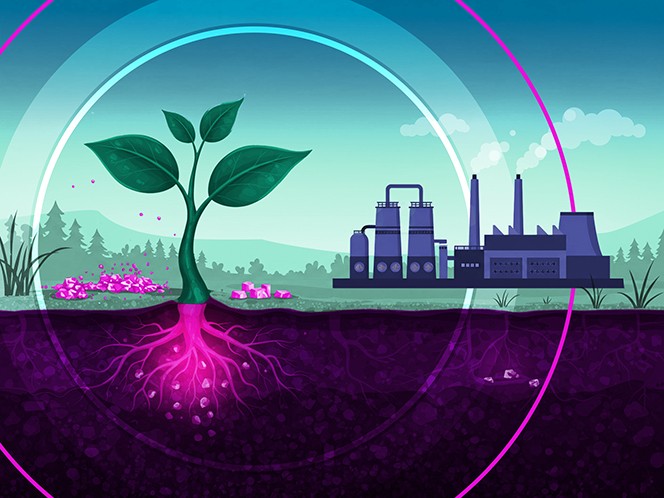Commercial farm extracts battery-grade nickel—and sequesters more CO2 than it produces
Posted: June 02, 2025

Each spring, valleys in the Albanian Alps fill with fields of bright, yellow flowers. The metals company, Metalplant, grows and harvests them, not for food—but for nickel. The plants—Odontarrhena chalcidica—are nickel hyperaccumulators. These knee-height, native Albanian plants naturally extract nickel from the soil and concentrate it in their stems and leaves. MetalPlant is one of a growing number of companies perfecting techniques for phytomining—using plants to extract valuable metals from soil.
Over 2% of Odontarrhena chalcidica’s dry weight can be nickel: about on par with raw nickel ore obtained through conventional mining. Metalplant harvests the plants and burns them to ash. In the right growing conditions, 20% of that plant ash is pure nickel, which Metalplant refines either into nickel salts or pure ingots.
Our Industrial Life
Get your bi-weekly newsletter sharing fresh perspectives on complicated issues, new technology, and open questions shaping our industrial world.
New developments in phytomining
Metalplant is one of just a few ventures that have successfully commercialized phytomining, most of them extracting nickel in Europe. But, recent innovations are expanding the practice to target new metals and new sites across the globe, everywhere from North America to Malaysia.
All plants end up accumulating some metals from the soil: think of the iron you get from wheat or potassium from bananas. But, hyperaccumulator plants, like Odontarrhena, extract metals in much greater quantities. While most hyperaccumulators selectively extract nickel, other plants hyperaccumulate other valuable and difficult-to-extract metals—particularly cobalt and rare earth elements, which, along with nickel, are critical for making batteries for the energy transition.
Phytomining is emblematic of the contemporary industrial economy: it requires expertise from geologists, agronomists, chemists and geneticists. The ideal phytomining plant accumulates a valuable metal at high rates and grows both quickly and sustainably on lands with high metal concentrations. Nickel-rich soils in Albania, South Africa, Malaysia and North America each require different plants that fit each area’s ecological niche. Growing Odontarrhena in the Northwestern U.S. initially failed because it quickly became invasive.
Last year, the U.S. government’s Advanced Research Projects Agency—Energy (ARPA-E) awarded $10 million to researchers and startups to engineer new hyperaccumulators that can sustainably extract nickel from U.S. soils, a project it calls, “Plant HYperaccumulators TO MIne Nickel-Enriched Soils,” or PHYTOMINES. Metalplant secured $1.7 million of that funding, which it is using with genetics firm, Verinomics, to create a sterile version of Odontarrhena that won’t become invasive in the nickel-rich soils of northern California and southern Oregon.
Other researchers are developing new nickel accumulators for use in the U.S. At the University of Florida, Dr. Jeongim Kim is working on modifying the Milkwort Jewelflower (Streptanthus polygaloides), which is native to the foothills of the Sierra Nevada mountains. In its natural form, it stores up to 0.6% nickel by dry weight, quite a lot, but significantly less than Albania’s Odontarrhena.
"The main objective of our project is to maximize the biomass and nickel extraction efficiency of this species," Dr. Kim said of the effort. "Using my knowledge to develop new plant genetic material that can contribute to energy fields and help solve some energy issues excites me."
How phytomining can benefit mining companies
Phytomining is essentially solar-powered metals extraction. Instead of generating energy to run mining equipment, phytomines just let plants do what they do: use photosynthesis to suck up nutrients from the soil. As they do so, they also sequester carbon dioxide from the atmosphere. As a result, phytomining can be far less carbon-intensive than conventional mining—even when taking into account the carbon released when burning the plants to ash.
Metalplant has even gone beyond low-carbon phytomining and now sells negative-carbon nickel. It uses hydroelectric power to crush olivine rocks from a quarry near its farms. It then spreads the crushed rock over the fields growing Odontarrhena. Because olivine is high in nickel, it provides even more nickel for the plants to extract from the soil. But also, as the crushed olivine sits in the field, it reacts with CO2 in the atmosphere, locking it up into stable bicarbonates that eventually wash away into the oceans, where it will be sequestered long-term.
Metalplant says the process—called enhanced rock weathering—results in a net 200 tonnes of CO2 removed from the atmosphere for every tonne of nickel its plants extract from the olivine. To keep track of how much carbon its mining operations sequester, it gathers data on soil geochemistry and analyzes it with a digital simulation model developed by the University of Sheffield.
Phytomining doesn’t compete with either conventional mining or agriculture. It’s best conducted in areas with serpentine or ultramaphic soils, which are high in nickel and other valuable metals. Such soils often don’t have metal concentrations high enough for conventional mining—but they are high enough to make them poisonous to most agricultural crops. Phytomining is the only way to pull the commercial value out of these lands.
Phytomining may also be an excellent way for mining companies to remediate mine tailings—and extract more profit from them in the process. For example, French company Econick is working with the DAUM crystal factory in Nancy to recover metals from its slagheap for reuse using hyperaccumulators.
Researchers have also explored using the South African plant, Berkheya coddii, to recover nickel and cobalt from contaminated soils near nickel smelters. In China, the fern, Dicranopteris linearis, grows on the tailings of a former rare earth elements mine, accumulating lanthanam, cerium and neodymium.
Nickel is so far the only metal currently mined at commercial scale, but plants are out there that can extract cobalt, rare earth elements and other materials in high demand for batteries and solar cells. It turns out that rare earth elements aren’t really all that rare: it’s just that they’re dispersed throughout the earth’s crust in low concentrations that make them difficult to extract with conventional mining methods. Hyperaccumulator plants may be just the tool miners need to efficiently extract these in-demand products.